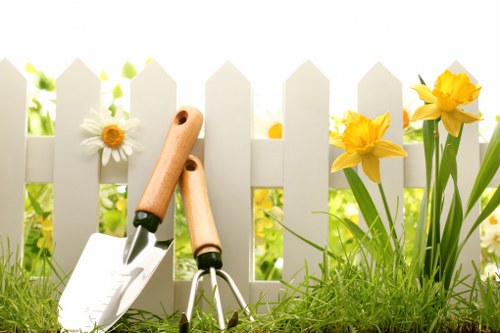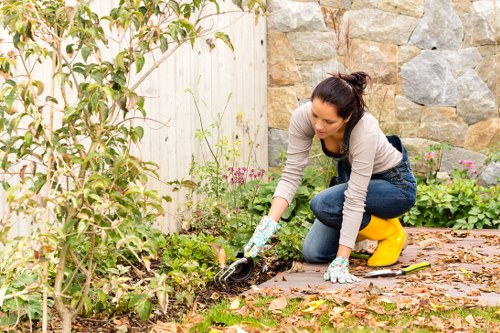Effective Driveway Algae Removal in Isle of Dogs

Isle of Dogs homeowners understand the frustration of dealing with unsightly algae on their driveways. Algae not only detracts from the appearance of your property but can also make surfaces slippery and hazardous. In this comprehensive guide, we will explore effective methods for driveway algae removal in Isle of Dogs, ensuring your driveway remains clean and safe.
Algae thrives in damp, shaded environments, making driveways the perfect breeding ground, especially during the rainy seasons common in London. The Isle of Dogs, with its unique climate and urban setting, is particularly susceptible to algae growth. Addressing this issue promptly can save you time and money in the long run.
Understanding the causes of algae growth is the first step towards effective removal. Factors such as moisture accumulation, organic debris, and lack of sunlight contribute significantly to the proliferation of algae on driveways.
Understanding Algae on Driveways

Algae are simple, plant-like organisms that thrive in moist environments. Unlike moss or fungi, algae can quickly cover large areas, creating a green, slippery surface that can be both unattractive and dangerous.
On driveways, algae can cause surface degradation over time. The presence of algae can lead to the weakening of driveway materials, making them more susceptible to cracks and other forms of damage.
Moreover, algae growth can contribute to an increased risk of accidents. Wet, algae-covered surfaces are notoriously slippery, posing a hazard to both pedestrians and vehicles.
Causes of Algae Growth in Isle of Dogs

The Isle of Dogs experiences a temperate maritime climate, characterized by frequent rainfall and moderate temperatures. These conditions create an ideal environment for algae to thrive.
Additionally, the urban landscape of the Isle of Dogs often results in shaded areas where sunlight is limited. Algae prefer shady, damp locations, making driveways in these areas particularly vulnerable.
Poor drainage can also contribute to algae growth. Water pooling on driveways provides the moisture necessary for algae to flourish, especially if the driveway material is porous or not adequately sealed.
Moisture Accumulation
Persistent moisture from rain and dew creates the perfect habitat for algae. Ensuring proper drainage and reducing water retention can help mitigate this issue.
Organic Debris
Leaves, twigs, and other organic materials can accumulate on driveways, providing nutrients for algae growth. Regular cleaning can prevent debris from fostering algae proliferation.
Lack of Sunlight
Algae thrive in shaded areas where sunlight is minimal. Trimming overhanging branches and ensuring adequate sunlight exposure can reduce algae growth.

Addressing algae growth involves a combination of removal and prevention strategies. By understanding the underlying causes, homeowners can implement effective solutions that offer long-term benefits.
Whether you choose to tackle the issue yourself or hire a professional algae removal service in Isle of Dogs, it's essential to use the right methods and products to ensure successful outcomes.
Next, we'll explore the benefits of removing algae from your driveway and the various methods available to achieve a clean and safe surface.
Benefits of Removing Algae from Your Driveway

Removing algae from your driveway offers several advantages, both aesthetic and practical. A clean driveway enhances the overall appearance of your property, increasing its curb appeal and potentially its market value.
Safety is another critical benefit. Algae can make surfaces slippery, increasing the risk of falls and vehicle accidents. By eliminating algae, you create a safer environment for your family and visitors.
Additionally, removing algae helps preserve the integrity of your driveway material. Algae can cause surface deterioration over time, leading to costly repairs or replacements if left untreated.
Methods for Algae Removal
Chemical Treatments
Chemical cleaners specifically designed for algae removal are widely available and effective. These products typically contain biocides that kill algae and prevent regrowth.
- Bleach Solutions: A mixture of bleach and water can effectively kill algae on driveways. However, it's essential to use this method cautiously to avoid damage to surrounding vegetation.
- Commercial Algae Cleaners: These are formulated to target algae specifically and often include ingredients that prevent future growth.
- Vinegar-Based Cleaners: For a more eco-friendly option, vinegar can be used to kill algae. While effective, it may require multiple applications.
Pressure Washing
Pressure washing is a powerful method for removing algae from driveways. The high-pressure water jet can dislodge and wash away algae without the need for harsh chemicals.
- Advantages: Quick and efficient, pressure washing can cover large areas in a short time.
- Considerations: It's essential to use the correct pressure setting to avoid damaging the driveway surface.
Eco-Friendly Solutions
For those seeking environmentally friendly options, there are several natural methods to remove algae. These solutions are safer for surrounding plants and beneficial microorganisms.
- Baking Soda: Sprinkling baking soda on algae and spraying with water can help kill and remove the growth.
- Hydrogen Peroxide: A 3% hydrogen peroxide solution can be sprayed on algae to eliminate it effectively.
- Dish Soap: Mixing dish soap with water increases the cleaning power against algae.

Choosing the right method depends on the extent of algae growth, the driveway material, and personal preferences regarding environmental impact. In some cases, a combination of methods may yield the best results.
Once the algae has been removed, it's crucial to implement preventive measures to ensure it doesn't return. Proper maintenance can keep your driveway algae-free year-round.
Next, we'll discuss strategies for preventing future algae growth, helping you maintain a clean and safe driveway.
Preventing Future Algae Growth

Preventing algae from returning involves addressing the root causes that allow it to thrive. Here are some effective strategies:
- Improve Drainage: Ensure that your driveway has proper drainage to prevent water from pooling. Installing drainage systems or regrading the driveway can help.
- Trim Vegetation: Reducing shade by trimming trees and shrubs increases sunlight exposure, making the environment less favorable for algae.
- Regular Cleaning: Removing debris and keeping the driveway clean reduces the organic matter that algae need to grow.
- Seal Your Driveway: Applying a sealant can create a barrier that prevents moisture from penetrating the surface, thereby inhibiting algae growth.
Implementing these preventive measures can significantly reduce the likelihood of algae returning, saving you time and effort on future clean-ups.
Now, let's explore how to choose the right algae removal service in Isle of Dogs to ensure professional and effective results.
Choosing the Right Algae Removal Service in Isle of Dogs
Selecting a reputable algae removal service is essential for achieving the best results. Here are some factors to consider when making your choice:
- Experience: Look for companies with a proven track record in algae removal and driveway maintenance.
- Methods Used: Ensure the service uses safe and effective methods, whether chemical, mechanical, or eco-friendly solutions.
- Customer Reviews: Reading reviews and testimonials can provide insight into the company's reliability and quality of work.
- Pricing: Obtain quotes from multiple providers to compare prices and services offered.
- Guarantees: Choose a service that offers satisfaction guarantees or warranties on their work.
By carefully evaluating these factors, you can select a professional algae removal service that meets your needs and ensures a clean, safe driveway.

Professional services not only remove existing algae but also provide advice and solutions to prevent future growth, offering long-term benefits for your property.
In addition to removing algae, maintaining a clean driveway enhances the overall aesthetic of your home and contributes to its value.
Finally, let's look at other areas near Isle of Dogs that also benefit from effective driveway algae removal services.
Nearby Areas for Algae Removal Services
The Isle of Dogs is surrounded by several neighborhoods and districts that may also require algae removal services. Here are some of the closest areas:
- Canary Wharf: Just adjacent to the Isle of Dogs, Canary Wharf offers both residential and commercial properties that may need algae management.
- Greenwich: Located to the south, Greenwich's older properties often have driveways susceptible to algae growth.
- Wapping: This historic area to the west is known for its cobblestone streets and driveways, which can harbor algae.
- Poplar: Located north of the Isle of Dogs, Poplar experiences similar climate conditions conducive to algae growth.
- Bow: East of the Isle of Dogs, Bow features a mix of residential driveways that benefit from regular maintenance.
- Blackwall: Adjacent to the Isle of Dogs, Blackwall's driveways can be prone to algae, especially in shaded areas.
- Regent's Canal: Areas along the Regent's Canal near the Isle of Dogs also see algae growth due to the proximity to water sources.
- Island Gardens: Situated to the west, Island Gardens' driveways require periodic algae removal to maintain their appearance.
- Millwall: Located on the east side, Millwall's driveways can accumulate algae in damp conditions.
- St. Peter’s: South of the Isle of Dogs, St. Peter’s driveways benefit from effective algae removal services.
- Limehouse: To the north, Limehouse's mix of residential and commercial properties often require algae management.
- Rotherhithe: Northwest of the Isle of Dogs, Rotherhithe's older driveways can be prone to algae growth.
- Silvertown: Nearby Silvertown is another area where driveway algae removal services are in demand.
- Bank Junction: East of the Isle of Dogs, Bank Junction's driveways need regular maintenance to prevent algae buildup.

Each of these areas shares similar environmental conditions with the Isle of Dogs, making effective algae removal and prevention strategies essential for maintaining driveways.
By addressing algae issues in these regions, homeowners can enhance the safety and appearance of their properties, contributing to the overall appeal of the neighborhood.
In conclusion, driveway algae removal in Isle of Dogs is a crucial maintenance task that ensures the longevity and safety of your driveway. By understanding the causes, implementing effective removal methods, and choosing the right service, you can keep your driveway clean and algae-free.
Frequently Asked Questions
1. What causes algae to grow on driveways?
Algae thrive in damp, shaded environments with limited sunlight. Moisture accumulation, organic debris, and poor drainage contribute significantly to algae growth on driveways.
2. Are chemical treatments safe for my driveway and the environment?
When used correctly, chemical treatments are safe for driveways. However, it's essential to follow the manufacturer's instructions to minimize environmental impact. Eco-friendly alternatives like vinegar or baking soda are also available.
3. How often should I clean my driveway to prevent algae growth?
Regular cleaning, at least once or twice a year, can prevent algae from establishing itself. Additionally, addressing moisture and debris accumulation promptly helps maintain a clean driveway.
4. Can I remove algae from my driveway myself, or should I hire a professional?
You can remove algae yourself using various cleaning methods. However, for extensive growth or to ensure thorough removal, hiring a professional algae removal service in Isle of Dogs is recommended.
5. How can I prevent algae from returning to my driveway?
Preventive measures include improving drainage, trimming vegetation to increase sunlight exposure, sealing your driveway, and keeping it free from debris and moisture buildup.


